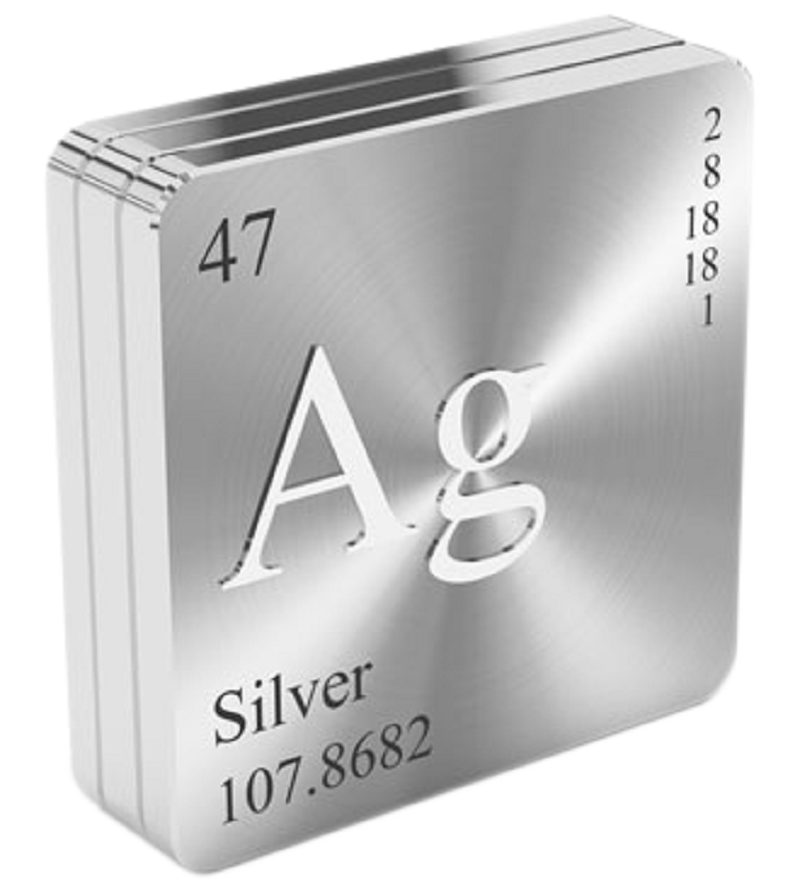Silver is classified among precious metals, which are attractive but not very chemically active. As their title indicates, precious metals are not very abundant in the Earth's crust. In fact, silver’s abundance in the Earth’s crust is estimated to be about 0.1 parts per million. It is also found in seawater, where its abundance is thought to be about 0.01 parts per million.
Used by humans for thousands of years, silver is often found as a free element in nature and can be extracted from its ores fairly easy. Ores rich in silver, however, disappeared long ago due to mining. Today, silver usually comes from ores that contain very small amounts of the metal. The metal is most commonly produced as a by-product of mining for other metals. After the primary metal has been removed, the waste often contains small amounts of silver that are extracted by electrolysis.
Silver is a very inactive metal that does not react with oxygen in the air under normal circumstances. However, it reacts slowly with sulfur compounds in the air; a reaction that produces silver sulfide (Ag2S), which is a black compound. The tarnish that develops over time on silverware and other silver-plated objects is silver sulfide.

The most flexible metal, silver can be drawn into thin wires and hammered into thin sheets. It is soft and white with a shiny surface that reflects light very well. However, silver’s most unique property is that it conducts heat and electricity better than any other element.
Electrical and electronic equipment are in fact the second most important use of silver. About 20% of all silver produced is used for this purpose. Silver is actually the most desirable of all metals for electrical equipment as electricity flows through it more easily than it does through any other metal. In most cases, however, metals such as copper or aluminum are used because they are less expensive.
Sometimes, an electrical device is so important that cost is not a consideration. For example, electrical devices on aircrafts, spacecrafts and satellites must work reliably and efficiently. The cost of using silver is not as important as it would be in a home appliance. Thus, silver is used for electrical wiring and connections in these devices.
About a fifth of all silver produced is used in a variety of other products. For example, it is often used in dental amalgams. Silver amalgams work well for filling decayed teeth because they are non-toxic and do not break down or react with other materials very readily.
The most important use of silver today, however, is photography. Taking a photograph depends on the simple chemical idea that light can cause electrons to move around.
Pure silver is converted to a compound; silver chloride (AgCl), silver bromide (AgBr) or silver iodide (AgI). In that reaction, while silver combines with chlorine, bromine or iodine to form the compound, each silver atom loses one electron to the other element atom. The silver atom becomes one electron short of what it usually has; hence, becoming a silver ion.
Photographic film is coated with a thin layer of silver ions, which are colorless. When the film is exposed to light, light gives energy to the electrons. Some of these electrons find their way back to silver ions, transforming them back to atoms and silver atoms are not colorless but black. Thus, a photographic film exposed to light turns black at every point where light strikes a silver ion.
In taking a picture, of course, not all of the film gets equal amounts of light. A picture will have areas that get more light than others; some places on the film become very dark, and other places become less dark. Additional steps are necessary to "develop" photographic film or to produce a picture from it but the first step in taking a photograph is changing silver ions back to silver atoms with light.
If it were not for the magic and power of chemistry; a science that is intertwined with almost every single aspect of the life we enjoy today, neither still or motion images, whether black and white or colored, would have emerged. Nonetheless, if it were not for chemical research and intervention, we would not have had the incredible gift of grasping memorable moments to cherish forever, and we would have missed the chance of exploring one of the most magnificent arts known to Mankind.

References
chemistryexplained.com
cci-icc.gc.ca
cheresources.com
*Published in the PSC Newsletter, Spring 2011 Issue.